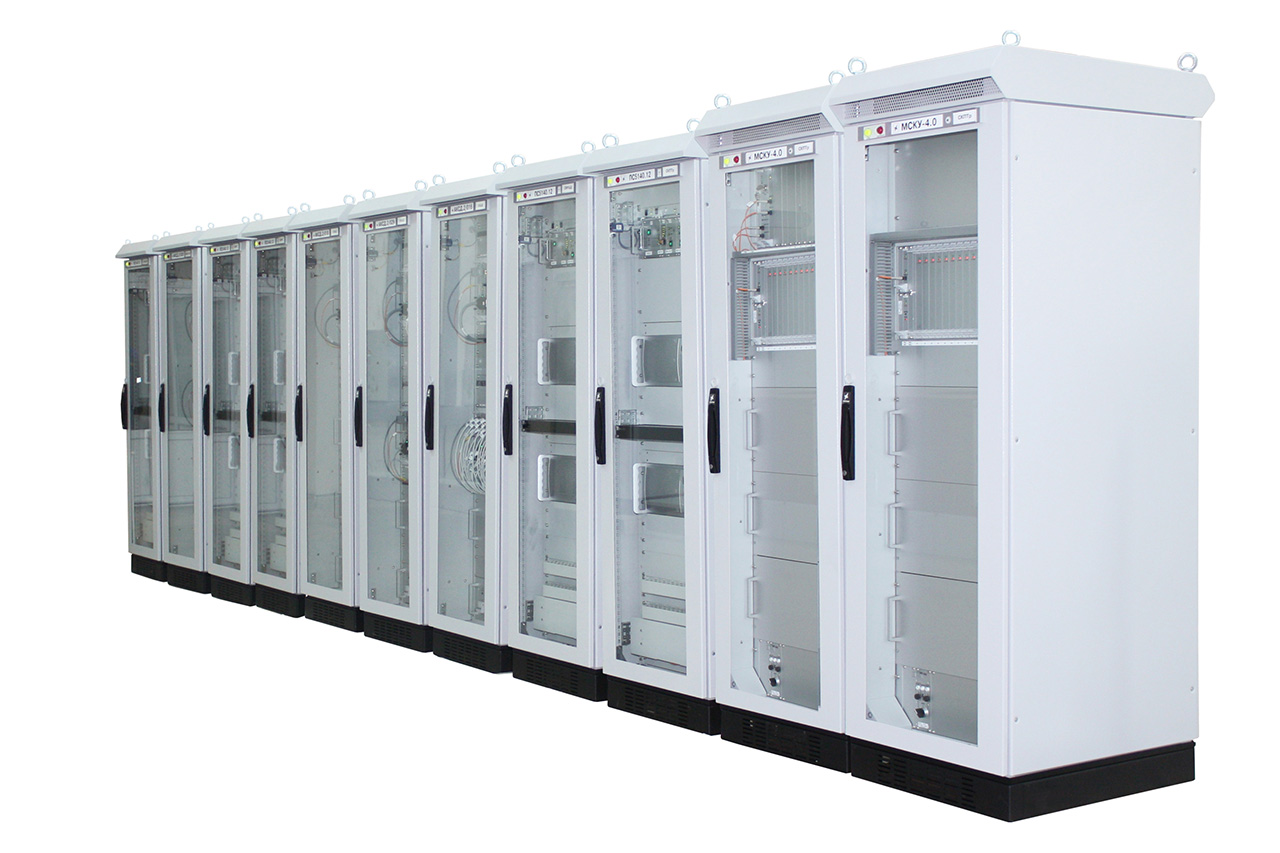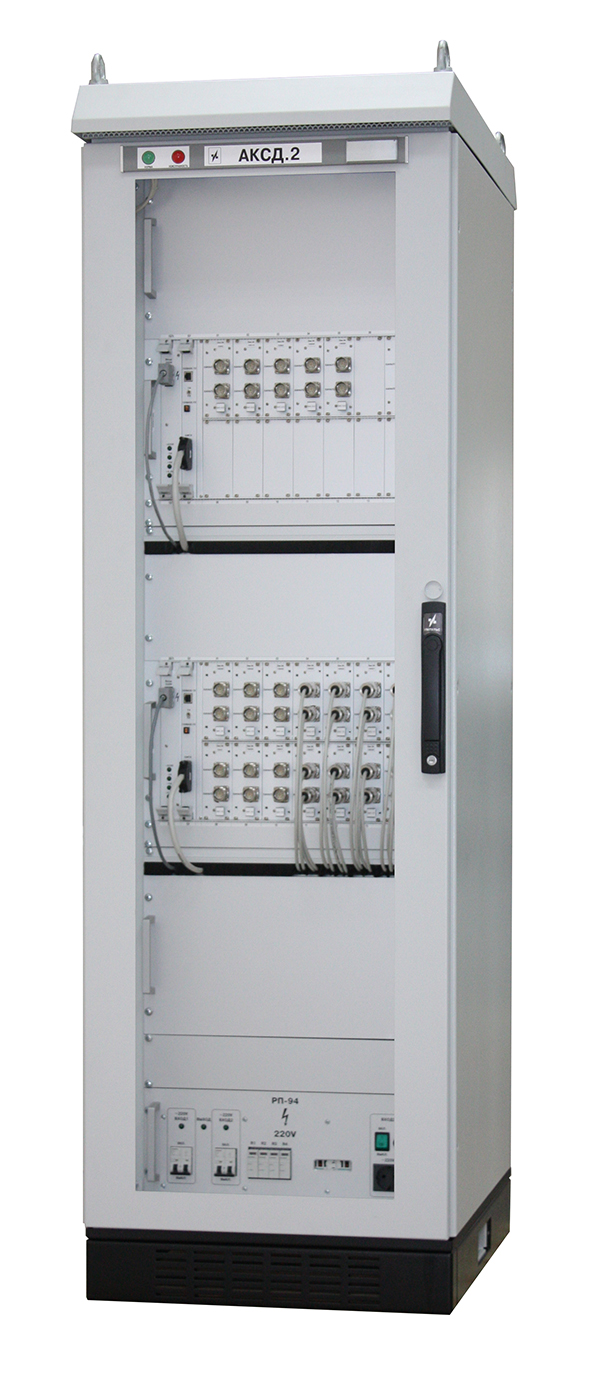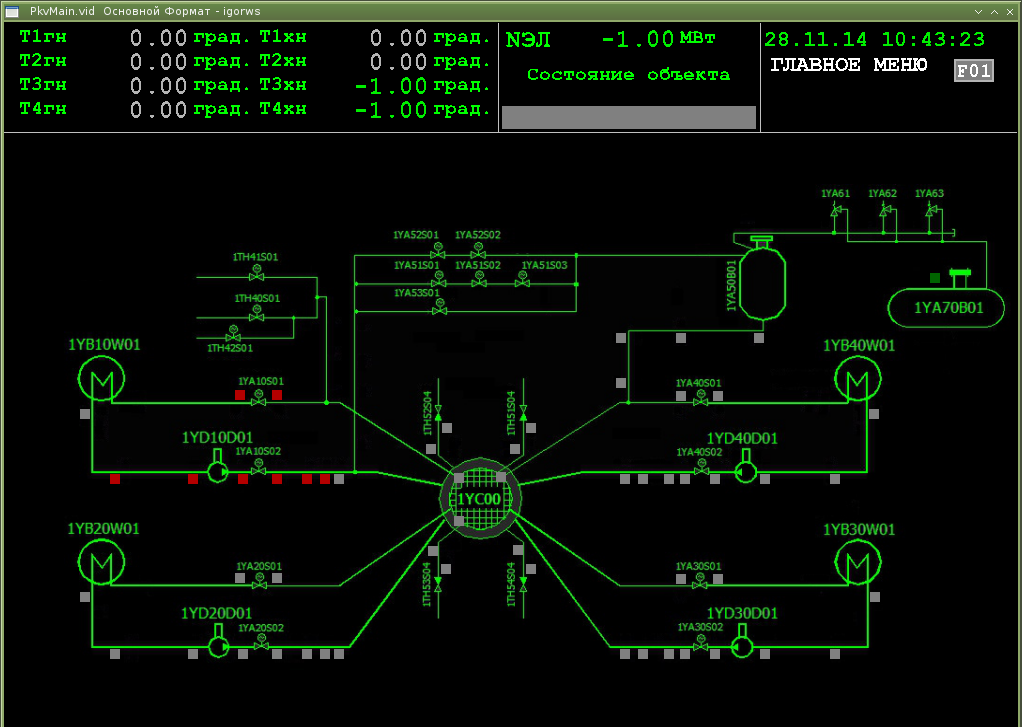COMPLEX DIAGNOSTICS SYSTEM FOR EQUIPMENT OF A REACTOR FACILITY’S PRIMARY CIRCUIT
|
Functions of KSD:
- deep complex technical diagnostics of main equipment of an RF’s primary circuit using comparison and analysis of diagnostic information received from unit’s instrumentation and control systems, local diagnostics systems, and own databases;
- providing a diagnostic engineer with centralized access to operating and archive diagnostic information received from different sources (IVS, local diagnostics systems, an automated radiation monitoring system, etc.) and allowing to determine and forecast technical state of operated RF’s primary circuit equipment;
- transferring parameters to be displayed to a personnel to a unit’s local area network.
Composition of KSD:
- KSD’s upper level system including:
- a redundant computing server of KSD based on two mutually redundant workstations;
- a workplace of a KSD diagnostic engineer based on two mutually redundant workstations;
- SVRShD vibration and noise diagnostics system;
- SOSP loose parts monitoring system;
- SKPT system of RF’s primary circuit coolant leakage monitoring;
- SVKD GCN system for vibration monitoring and diagnostics of reactor coolant pumps;
- SDOR fatigue monitoring system;
- SKPTr system of pipeline displacement monitoring.
|
|
|
SVRShD vibration and noise diagnostics system
The system is intended for monitoring and diagnostics of vibration state of RF’s primary circuit equipment, for monitoring of:
- trajectory of thermal displacement of RF’s primary circuit main equipment in heating/cooling modes for detection of non-project displacement trajectories caused by defects in pillars of monitored equipment;
- vibration state of RF’s primary circuit main equipment, including a reactor vessel, for detection of abnormal vibrations caused by change in pillar rigidity, weakening of equipment attachment points, or intensification of vibration causing powers;
- vibration state of fuel rod assemblies for detection of abnormal vibrations caused by weakening of attachment points or intensification of coolant influence;
- vibration state of a reactor shaft for detection of abnormal vibrations caused by wearout of attachment points or intensification of coolant influence.
Functions of SVRShD:
- inputting, converting, and comparing with setpoints signals from vibration sensors, vibration displacement sensors, neutron detection units, and direct charge sensors (possibility of reception of noise signals from all RF’s DPZ sensors – totally 448 signals);
- receiving information on RF technological parameters from unit’s IVS;
- archiving monitoring and diagnostic data;
- calculated diagnostics of vibration state considering current and archive data, generating reports;
- transferring information on state of diagnosed equipment to a computing server of KSD.
Composition of SVRShD:
- piezoelectric vibration transducers, relative displacement sensors, detection units;
- neutron detector signal converters;
- measuring equipment based on AKSD.2 complex diagnostics system equipment;
- an SVRShD’s computing server based on a PS5140 workstation.
|
|
|
SOSP loose parts monitoring system
The system is intended for early detection and determination of loose parts and poorly fixed equipment details in coolant stream using acoustic sensors installed on the surface of RF’s primary circuit equipment.
Functions of SOSP:
- inputting, converting, and comparing with setpoints noise signals from acoustic sensors;
- monitoring vessel noise of main equipment and RF’s primary circuit pipelines, detecting loose and poorly fixed items (with the mass of 0.05 kg and more at the distance of 1 m from a primary transducer) in coolant stream;
- archiving data, listening and recording acoustic signals;
- monitoring operability of channels that receive and process signals of sensors;
- displaying diagnostics results to an operator and transferring to a computing server of KSD.
Composition of SOSP:
- acoustic sensors (piezoelectric vibration transducers);
- impulse hammers;
- a station for power supply of impulse hammers;
- measuring equipment based on AKSD.2 complex diagnostics system equipment;
- an SOSP’s computing server based on a PS5140 workstation.
|
|
|
SKPT system of primary circuit coolant leakage monitoring
The system is intended to monitor tightness of equipment and pipelines of RF’s main circulation circuit, to detect RF’s primary circuit coolant leakage in time, to assess its magnitude in normal operation modes, with deviations from normal operation, and in a “small leakage” mode.
Functions of SKPT:
- inputting, converting, and comparing with setpoints signals from humidity and temperature sensors, acoustic sensors;
- receiving information from a unit’s process information system;
- complex analysis on localization (with deviation not more than ± 2 m) and magnitude of a leakage with minimal registered coolant flow 1 l/min in the time period of not more than 10 min from the time of its actual occurrence;
- archiving data;
- displaying diagnostics results to an operator and transferring to a computing server of KSD;
- generating warning alarm.
Composition of SKPT:
- a subsystem of acoustic monitoring (PAK) including:
- acoustic sensors;
- measuring equipment based on AKSD.2 complex diagnostics system equipment;
- an SKPT PAK’s computing server based on a PS5140 workstation;
- a subsystem of humidity monitoring (PKV) including:
- a relative humidity and temperature sensor;
- measuring equipment based on AKSD.2 complex diagnostics system equipment;
- SKPT PKV’s computing server based on a PS5140 workstation.
|
|
|
SVKD GCN system for vibration monitoring and diagnostics of reactor coolant pumps
The system is intended for monitoring of vibrational parameters of reactor coolant pumps (GCN) for early detection of abnormal states of mechanical and electrical parts, technical state forecasting based on complex analysis of vibrational characteristics and thermal parameters.
Functions of SVKD GCN:
- inputting, converting, and comparing with setpoints signals from vibration monitoring sensors;
- continuously monitoring GCN vibrational state and identifying slowly developed defects;
- monitoring vibrational characteristics in different modes of GCN operation, including rotor rundown mode during electric motor power supply shutdown;
- analyzing, archiving, and logging data;
- diagnosing GCN state with display of results to a diagnostic engineer and generation of alarm.
Composition of SVKD GCN:
- vibration monitoring sensors;
- primary converters of signals of GCN sensors;
- measuring equipment based on AKSD.2 complex diagnostics system equipment;
- an SVKD GCN’s computing server based on a PS5140 workstation.
|
|
|
SDOR fatigue monitoring system
The system is intended to calculate cumulative fatigue damage dealt to metal in the most stressed points of a structure and to evaluate remaining lifetime of elements of main equipment of the RF’s primary circuit (a reactor with a cover without in-core equipment, a pressurizer, steam generators, main circulatory pipelines, emergency core cooling system’s and pressurizer’s pipelines) based on continuous monitoring of thermotechnical parameters in different modes of RF operation.
Functions of SDOR:
- inputting and converting signals from thermal control sensors (monitoring of thermal pulsations and coolant stratification), collecting and accumulating information received from a computing server of KSD;
- calculating fatigue damage and remaining lifetime in control (the most stressed) points;
- assessing remaining lifetime of equipment and pipeline metal;
- maintaining databases, registering signals received from IVS, KSD, and own sensors;
- providing information to operative personnel.
Composition of SDOR:
- temperature sensors (thermocouples);
- an I&C complex based on an MSKU industrial controller;
- an SDOR’s computing server based on a PS5140 workstation.
|
|
|
SKPTr system of pipeline displacement monitoring
The SKPTr system is intended to measure continuously and to record maximum pipeline displacements under conditions of unit normal operation and transient modes (startup, stop, partial load decreasing) for provision of operating and technical personnel with information.
Functions of SKPTr:
- receiving and processing signals of three-axis displacement sensors, receiving technological signals of pressure and temperature in a steam generator;
- continuously remotely monitoring pipeline displacement by three mutually perpendicular axes and maintaining a database;
- providing an operator with pipeline displacement information as videograms;
- transferring information on displacements and violations of permissible displacement limits to adjacent systems;
- providing unit personnel with information on faults and failures, generating alarm on impermissible pipeline displacements.
Composition of SKPTr:
- a DTP three-axis displacement sensor;
- an I&C complex based on an MSKU industrial controller;
- an SKPTr’s computing server based on a PS5140 workstation.
|
|
System advantages:
- consolidation of a wide variety of RF’s primary circuit equipment diagnostic functions in a unified system while maintaining autonomy of local diagnostics systems;
- complex and reliable determination of RF’s damaged or worn out equipment due to availability of local diagnostics systems with different methods of assessment of monitored parameters;
- time-tested diagnostic algorithms of KSD allow to assess intensity of damaging factors and to recommend on a reasonable basis deeper assessment of technical state of unit’s elements and repair procedures considering current technical state of RF’s equipment;
- construction and location of sensor attachment nodes on pipelines assure easy mounting and unhindered periodic monitoring of pipeline metal without accompanying dismantling of the attachment nodes;
- comfort of operation due to the ergonomic user’s interface and a developed system for provision of operating personnel with current and retrospective information;
- use of unified hardware.
Safety class – 4.
Safety category of KSD – not classified.
Implementation facilities:
- Zaporizhzhya NPP, units 1- 5
- Rivne NPP, units 1-4
- Khmelnitsky NPP, units 1, 2
- South-Ukraine NPP, units 1-3











